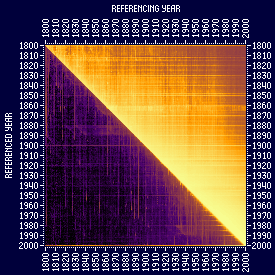A history of time in 40,000 pixels
How did past writers view their past, and their future? The following chart shows, year by year, how frequently all other years are referenced:

Google Ngrams shows us the frequency of phrases over time. Their standard example shows the increasing popularity of “Frankenstein” between the years 1800 and 2000. But what if, instead of phrases, we ask for how frequently a year is referenced, like the year “1848”? Then we can visualize, in one square, past writers’ views of time.
The top-right triangle represents “writing about the past,” while the bottom-right triangle represents “writing about the future,” and the diagonal line between them represents “writing about the present.” Naturally, writers talk more about past years than future, but they write much more about the recent past.
“Writing about the past” is marked by strong horizontal streaks: years which writers write more about. Most of them are decades, or markers for periods: “1900” is very strong, probably from references to that century.
But some specific years stand out as interesting. 1848 is strong: a year famous for a wave of revolutions across Europe. A band between 1860 and 1865 marks the American Civil War. 1914 marks the start of the First World War. A hotspot between 1812 and 1815 marks the Napoleonic Wars (not the 1812 Overture, which debuted in 1882). Unlike the American Civil War, the Napoleonic Wars seem to have faded from public consciousness: we don’t write much about those times any more.
“Writing about the future”, by contrast, is marked by horizontal, vertical, and diagonal streaks! What could all of those be? The horizontal streaks show interest in a future period. The streak along 1950 shows that writers as far back as 1800 were speculating about the period around 1950s. The vertical streaks presumably show single works writing detailed stories about the future.
But my favorites are the diagonal streaks. Do you see that faint diagonal streak of continued publications writing about “100 years from now”? You can see 1800 writing about 1900, 1801 writing about 1901, etc. Other diagonals mark publications of the style “50 years from now”, “10 years from now”, etc.
Finally, note how much more confident twentieth-century writers are in talking about the future! For nineteenth-century writers, the near future was unguessable: their line between future and past is very stark. Note, by contrast, the bottom right, such as note those five-year streaks between 1960 and 1990. What are these, Soviet five-year plans? Whatever they are, these twentieth-century writers are writing confidently about the future. I’m reminded of the mid-twentieth-century fashion for optimistic futurology, spurred by the rapid technological advances in that period.
This page copyright James Fisher 2018. Content is not associated with my employer.
 Granola
Granola